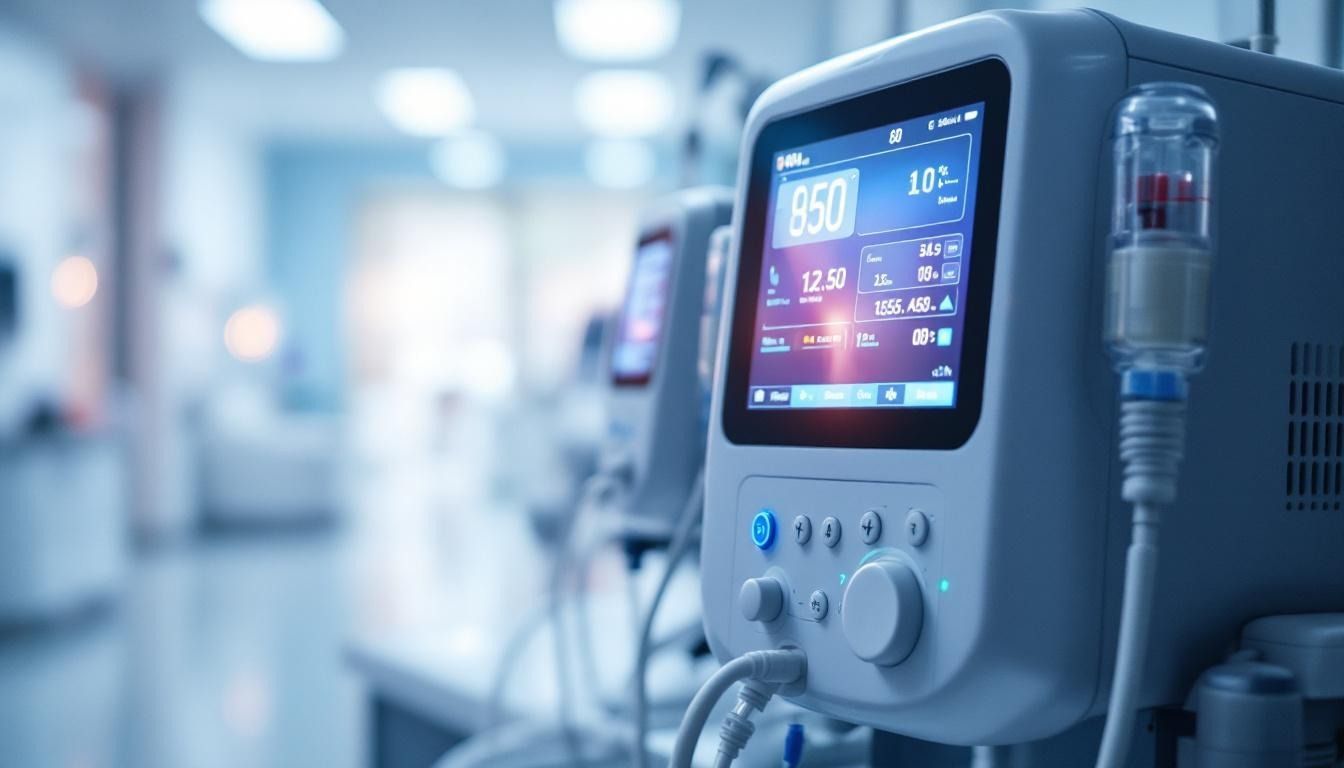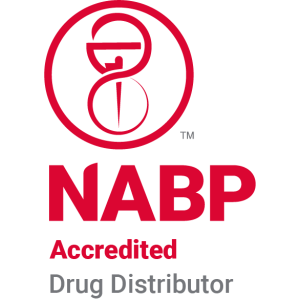The Pros and Cons of TPN vs. Tube Feeding for Malnutrition
Understanding Nutritional Support Options for Malnutrition
Malnutrition remains a significant clinical challenge, especially in patients with impaired or non-functional gastrointestinal systems. The choice between Total Parenteral Nutrition (TPN) and enteral (tube) feeding is critical, shaped by numerous medical, anatomical, and situational factors. This article explores the key differences, benefits, risks, and decision-making considerations involved in selecting appropriate nutritional support for malnourished patients.
Overview of Nutritional Support Modalities

What are the main differences between Total Parenteral Nutrition (TPN) and enteral (tube) feeding?
Total Parenteral Nutrition (TPN) is delivered directly into a large vein via an intravenous catheter, bypassing the digestive system entirely. It provides a complete nutritional mixture, including carbohydrates, proteins, fats, vitamins, and minerals, typically administered over 10 to 24 hours. TPN is primarily used when the gastrointestinal (GI) tract cannot be used effectively, due to conditions like bowel obstruction, perforation, or severe malabsorption.
In contrast, enteral (tube) feeding involves delivering liquid nutrients directly into the stomach or small intestine through a feeding tube. This method leverages the natural digestive process, supporting gut function, immune health, and maintaining mucosal integrity. Enteral nutrition can be administered via various tubes such as nasogastric, gastrostomy, or jejunostomy tubes.
While TPN bypasses the GI tract, enteral feeding utilizes it, making the latter more physiological. TPN is typically reserved for long-term or complex cases with non-viable GI function, whereas tube feeding may be used temporarily or long-term if the gut can absorb nutrients but oral intake is inadequate or unsafe.
When should TPN be used instead of enteral nutrition?
TPN is the preferred method when the GI tract is non-functional or cannot be used effectively. This includes scenarios such as bowel obstruction, perforation, severe malabsorption, or extensive bowel resections that result in short bowel syndrome.
It’s indicated when the gut is accessible but cannot tolerate enteral feeding due to poor motility, inflammation, or after surgeries or radiotherapy affecting swallowing or gut integrity. For instance, patients with extensive small bowel disease or in cases of intestinal failure rely on TPN for nutritional sustenance.
Clinical assessment by a multidisciplinary team evaluates the patient’s overall condition, risks, and expected duration of nutritional support. Although enteral feeding remains the first choice whenever feasible, TPN is essential in situations where enteral nutrition is contraindicated or inadequate.
What are the advantages of tube feeding over TPN?
Tube feeding offers several benefits. It has a lower risk of bloodstream infections because it avoids placing a central venous catheter, which is common in TPN. Maintaining the gut’s function through enteral nutrition helps preserve the mucosal barrier, promotes immune health, and reduces bacterial translocation.
It is generally less costly, easier to administer, and less invasive, often being performed at bedside with minimal anesthesia. Additionally, tube feeding promotes gastrointestinal integrity, reducing the risk of intestinal atrophy, which can occur with the lack of enteral stimulation.
From a safety perspective, the lower complication risk makes tube feeding preferable for long-term use, especially for chronic patients. It also supports early recovery of gut function, potentially shortening hospital stays.
What are the risks and disadvantages associated with TPN?
TPN carries significant risks. Bloodstream infections are among the most serious complications, often related to catheter insertion or maintenance. Metabolic disturbances, such as hyperglycemia or electrolyte imbalances, require meticulous monitoring.
Long-term TPN therapy can result in liver dysfunction, including fatty liver changes or cholestasis, along with vascular complications like thrombosis or embolism. Nutritional imbalances, including deficiencies or excesses of trace elements, also pose concerns.
Additionally, TPN is costly, requiring specialized formulation and ongoing supervision by healthcare professionals. The invasive nature of central venous access increases the risk of mechanical complications, and improper management can lead to severe adverse outcomes.
What factors influence the choice between TPN and enteral nutrition?
The primary determinant is the functionality of the GI tract. If the patient’s gut can absorb and tolerate nutrients, enteral feeding is generally preferred due to lower risks and better support for gut health.
When the GI tract is compromised or inaccessible—due to obstruction, perforation, severe motility issues, or extensive bowel resection—TPN becomes necessary.
Other factors include the duration of support, patient’s overall condition, risk of aspiration, and potential for complications. Critical illness, postoperative state, or specific gastrointestinal diseases influence this decision.
What are the clinical considerations and decision factors when choosing a nutritional support method?
Clinicians assess multiple parameters: the patient’s nutritional status, GI tract competence, disease severity, risk of aspiration, and coexisting conditions.
Early initiation of nutritional support within 24-48 hours in critically ill or postoperative patients has been associated with better outcomes.
The feasibility of discreet, safe, and effective delivery influences choice—tubal feeding is less invasive and easier to implement long-term.
Ongoing evaluation to adjust nutrition methods in response to clinical changes is vital. Multidisciplinary teams — including physicians, dietitians, and nurses — guide tailored plans suited to patient needs.
Are there specific risks associated with TPN and how can they be mitigated?
TPN’s risks include catheter-related bloodstream infections, which can be minimized by strict aseptic technique during line insertion and maintenance.
Electrolyte imbalances, hyperglycemia, and liver issues require regular laboratory monitoring, prompt adjustments in nutrient formulations, and vigilant clinical observation.
Proper catheter care, timely removal of infected lines, and staff training significantly reduce infection rates.
In addition, individualized nutrient formulations and careful management of fluid and electrolyte balance help prevent metabolic disturbances.
| Method | Advantages | Risks and Disadvantages | Ideal Use Cases |
|---|---|---|---|
| Enteral (Tube) Feeding | Supports gut function, lower infection risk, less costly | Aspiration, tube dislodgement, GI intolerance, metabolic issues | Patients with a functioning GI tract unable to eat enough |
| Total Parenteral Nutrition (TPN) | Bypasses GI, customized nutrients, essential for gut rest | Infection, metabolic disturbances, liver issues, cost | GI non-function, bowel obstruction, severe malabsorption |
Overall, the choice between TPN and enteral nutrition depends on a careful assessment of patient-specific factors, balancing benefits with potential risks to optimize clinical outcomes.
Physiological and Immunological Impact of Enteral Nutrition
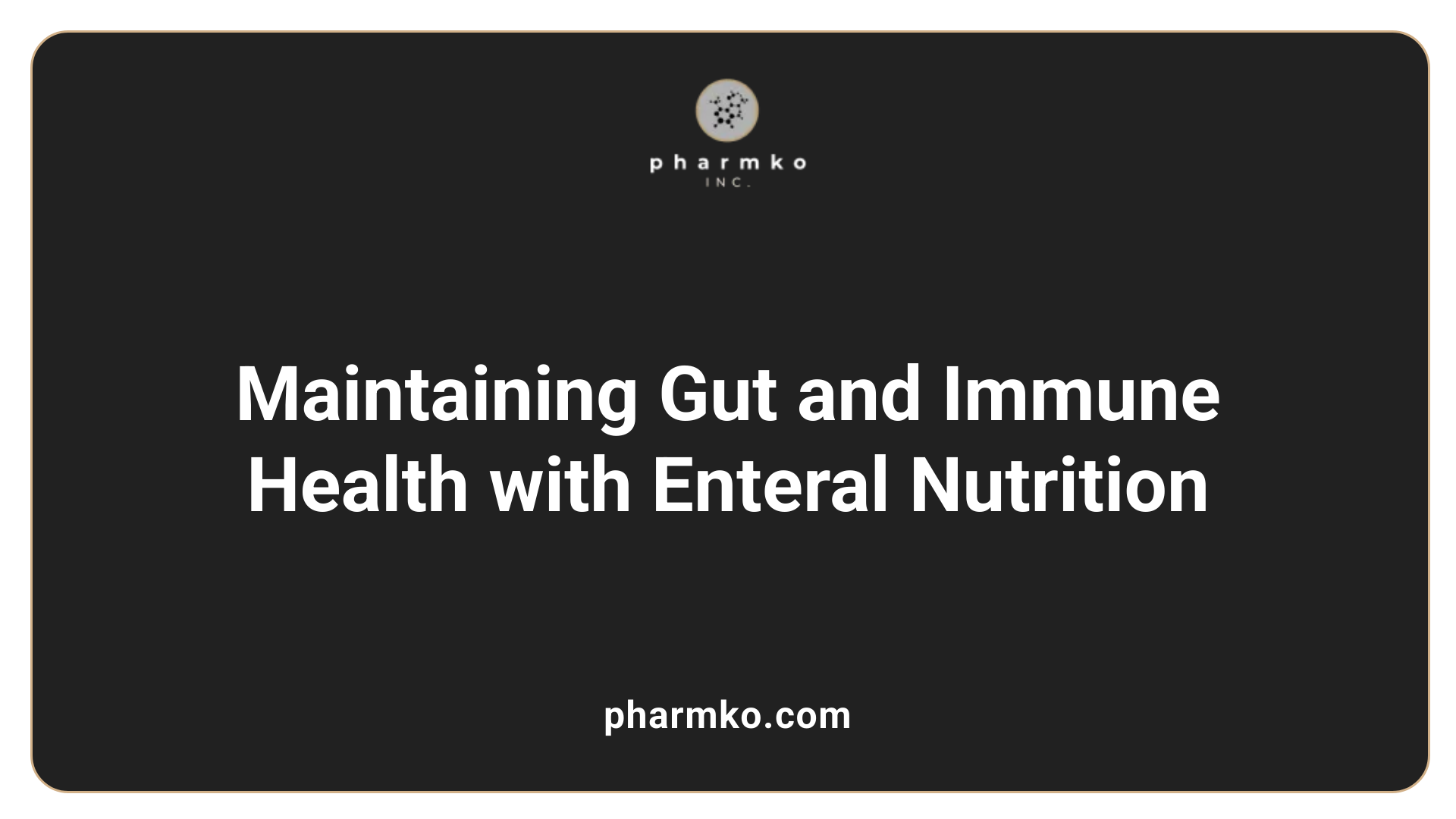
What are the benefits of enteral nutrition in preserving gut and immune function?
Enteral nutrition plays a vital role in maintaining the structural and functional integrity of the gastrointestinal (GI) mucosa. When patients receive nutrients through the GI tract, it stimulates mucosal cells, preservation of mucosal thickness, and the overall integrity of the gut barrier. This is especially important in critically ill and malnourished patients, as a healthy gut barrier prevents bacterial translocation, which can lead to systemic infections.
Furthermore, enteral feeding supports the gut-associated lymphoid tissue (GALT), which is crucial for local and systemic immune responses. By nourishing the immune tissue within the gut, enteral nutrition enhances immune defenses and reduces susceptibility to infections.
Animal studies have provided strong evidence for these benefits. For instance, research indicates that enteral feeding reduces systemic inflammation and supports the immune system’s functionality. This evidence is supported by human studies demonstrating that patients fed via the enteral route experience fewer infections, reduced inflammatory markers, and improved outcomes in critical illnesses.
Overall, preserving gut mucosa and immune tissue through enteral nutrition helps prevent complications such as infections, sepsis, and systemic inflammatory response syndrome (SIRS), which are common in patients with compromised health or those experiencing severe illness.
Medical Applications and Indications for TPN and Enteral Feeding
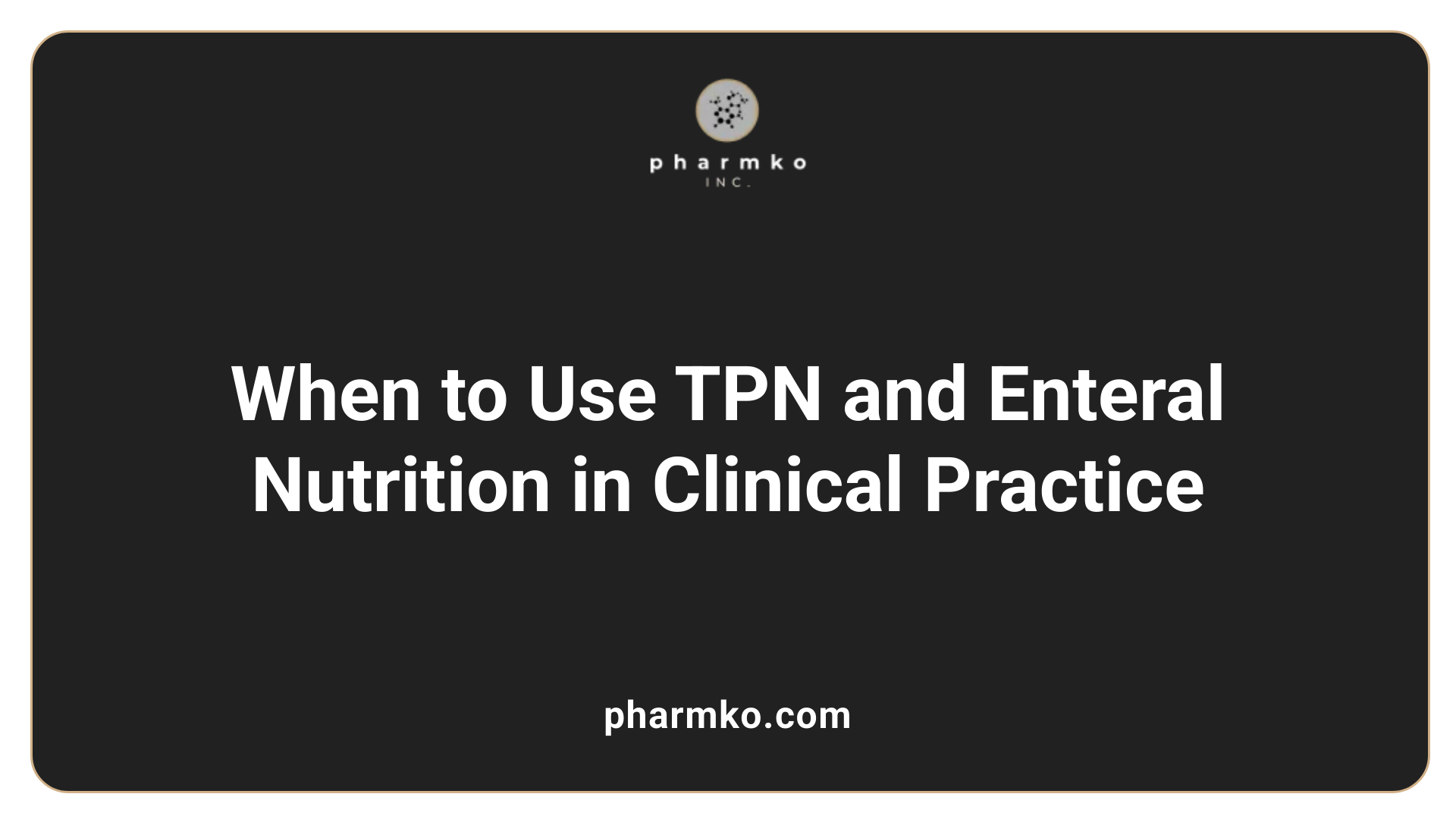
In what clinical situations is TPN indicated?
Total Parenteral Nutrition (TPN) is mainly used in severe cases where the gastrointestinal (GI) tract cannot be used or is heavily impaired. These situations include bowel obstruction, perforation, short bowel syndrome, paralytic ileus, or extensive bowel resection. TPN becomes essential when conditions like Crohn’s disease, ischemic bowel, or post-surgical GI disruption prevent normal digestion and absorption.
Moreover, TPN is life-saving for patients with severe malabsorption, tumor-related intestinal obstructions, or when early oral or enteral feeding is contraindicated or impossible. This includes cases of severe trauma, burns, or during specific cancer treatments such as radiotherapy. The therapy provides complete nutritional support by delivering nutrients directly into the bloodstream, bypassing the digestive system entirely.
When is enteral nutrition favored in clinical practice?
Enteral nutrition (EN) is generally preferred when the digestive system functions properly and can absorb nutrients safely. It is favored in a variety of scenarios such as post-stroke dysphagia, head or neck cancers, neurological disorders affecting swallowing, and during early critical illness to prevent gut atrophy.
Additionally, EN is suitable for patients with mild to moderate malnutrition, especially after surgical interventions or in chronic conditions like dementia. Its less invasive nature, lower cost, and fewer complications make it the first choice in many settings.
EN also helps preserve gut integrity, supports immune function, and reduces systemic infections, making it a vital component of nutritional management in healthcare.
Are there specific disease states where TPN should be avoided?
While TPN can be crucial in certain conditions, it should generally be avoided or used cautiously in patients with high risks of infection or vascular access problems. For example, in patients where the risk of bloodstream infections is high or where reliable vascular access cannot be established, TPN poses significant hazards.
Furthermore, TPN is often avoided when nutritional support is not expected to improve patient outcomes, such as in terminal illnesses where artificial nutrition may not contribute to quality of life. Its high cost, complexity, and associated risks like metabolic disturbances and liver complications necessitate careful clinical judgment. In absence of clear indications, or when less invasive options suffice, clinicians favor enteral routes.
What are the considerations for pediatric and neonatal patients?
In pediatric and neonatal populations, TPN is frequently required when congenital intestinal anomalies, short bowel syndrome, or postoperative recovery from gastrointestinal surgery hinder adequate enteral feeding.
Pediatric TPN formulations are meticulously tailored to meet the specific growth, developmental, and metabolic needs of children. It requires continuous monitoring and support from specialized pediatric nutrition teams.
Risks include metabolic bone disease, liver issues, and micronutrient deficiencies, demanding diligent management. Longer-term TPN use in children often takes place at home, with caregivers trained in infusion techniques, emphasizing the importance of ongoing medical supervision and careful adjustment of nutrition plans.
How do the clinical indications differ in specific conditions such as cancer or critical illness?
In cancer patients, TPN may be employed when the tumor infiltration, surgical removal, or treatment-related mucositis impair oral or enteral feeding. It helps maintain weight, support the immune system, and improve treatment tolerance.
In critically ill patients, early enteral nutrition—started within 24 to 36 hours—is highly recommended to preserve gut integrity, reduce infection risk, and accelerate recovery. TPN is reserved for cases where enteral feeding is contraindicated, such as bowel paralysis or severe malabsorption.
The goal in both scenarios is to optimize nutritional status to support healing and immune function. The choice of route and timing depends on the patient's clinical stability, gastrointestinal function, and specific needs, emphasizing a tailored approach to nutritional support.
Comparison of Complication Profiles and Monitoring Needs
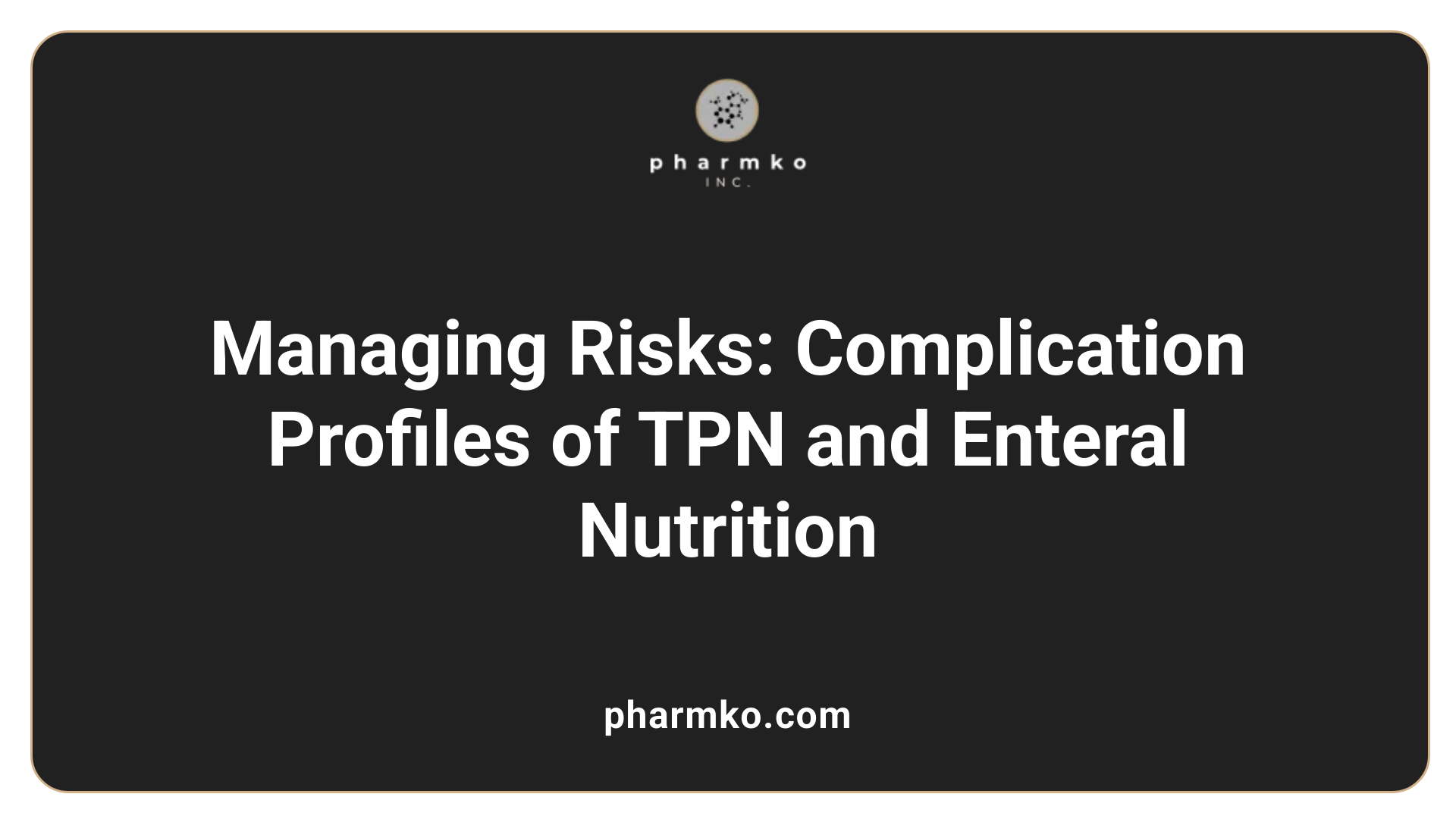
What are common complications associated with TPN and how can they be mitigated?
Total Parenteral Nutrition (TPN) is a life-saving intervention for patients with severely impaired or non-functional gastrointestinal tracts. However, it carries significant risks. Bloodstream infections are among the most common complications, often related to catheter use. Metabolic disturbances such as hyperglycemia, electrolyte imbalances, and liver dysfunction can also occur. Vascular issues like thrombosis further increase the risk.
To mitigate these complications, strict aseptic techniques during the insertion and maintenance of central venous catheters are critical. Regular monitoring of blood glucose levels, liver function tests, electrolytes, and triglycerides helps detect issues early. Tailoring the nutritional formulation to the patient's specific needs reduces metabolic risks. Ensuring meticulous line care and early detection of infection signs significantly lowers the chance of sepsis. Additionally, staff training and adherence to strict protocols are fundamental in preventing severe adverse outcomes.
What complications are linked to enteral feeding, and how are they managed?
Enteral feeding, while generally safer and more physiological than TPN, is not without risks. Aspiration pneumonia remains a primary concern, especially if the tube is misplaced or if the patient has impaired consciousness. Tube dislodgement and clogging can interrupt nutrition delivery and require prompt correction.
Gastrointestinal disturbances such as diarrhea, constipation, or nausea can also occur. Refeeding syndrome in malnourished patients is another serious complication. Management strategies include verifying proper tube placement through imaging or pH testing, regular site care, and monitoring patient tolerance.
Adjusting feeding formulas, administering prokinetics to improve gastric motility, and ensuring adequate water and electrolyte balance are crucial steps. Educating staff and caregivers on timely management of complications and intervention can significantly enhance safety and efficacy.
How does the risk of infection compare between TPN and tube feeding?
Research indicates that enteral nutrition via tube feeding has a noticeably lower risk of infection compared to TPN. This is primarily because TPN involves the placement of a central venous catheter, which is a potential site for bloodstream infections. In contrast, most enteral feeding methods do not require invasive bloodstream access.
The statistical data support this, showing a relative risk reduction for infections such as sepsis in patients receiving tube feeding. Moreover, standard care that supports oral intake or traditional feeding routes further reduces infection risks.
The lower incidence of infection makes enteral nutrition the preferred method whenever feasible, especially considering the severe consequences linked to catheter-related bloodstream infections.
What are the monitoring protocols necessary for safe TPN administration?
Ensuring the safety of TPN involves comprehensive and regular monitoring. Blood glucose levels should be checked frequently to avoid hyperglycemia. Electrolytes, liver enzymes, and renal function tests are conducted regularly to detect metabolic disturbances early.
Serum triglycerides are monitored to prevent hyperlipidemia, and catheter sites are examined routinely for signs of infection or thrombosis. Monitoring weight, input-output balance, and clinical status helps adjust the formulation and fluid management accordingly.
Long-term TPN therapy requires periodic review of micronutrient levels, including vitamins and minerals. Imaging studies or line inspections may be necessary to detect vascular complications.
Strict aseptic protocols during preparation and administration are essential, along with thorough staff training on complication recognition and intervention. This comprehensive approach minimizes risks and optimizes patient outcomes.
| Aspect | Enteral Nutrition | Parenteral Nutrition | Comparison Details |
|---|---|---|---|
| Risks | Aspiration pneumonia, dislodgement, clogging, GI issues | Infection, metabolic disturbances, vascular complications | Enteral safer regarding infections; risks differ in nature |
| Monitoring | Tube placement, tolerance, GI symptoms | Blood glucose, electrolytes, liver function, catheter site | Different parameters, both critical for safety |
| Management | Proper tube care, adjusting formulas, early detection | Line care, metabolic regulation, infection control | Strategies tailored for each method |
| Infection Risk | Lower | Higher | Significantly lower in enteral feeding |
| Cost | Generally lower | Higher | Cost-effective advantage of EN |
| Overall Outcome | Preserves gut function, reduces infection | Essential when gut cannot be used | Choice driven by patient condition |
This comparison underscores the importance of selecting the appropriate nutritional support method based on patient condition, potential risks, and required monitoring protocols to ensure safety and efficacy.
Long-term Considerations and Quality of Life Aspects
What are the challenges of long-term TPN use?
Long-term use of total parenteral nutrition (TPN) presents several significant challenges that require careful management. One of the main concerns is the risk of catheter-related bloodstream infections, which can lead to serious complications such as sepsis. Regular monitoring of the infusion site, strict aseptic techniques, and proper catheter care are essential to reduce this risk.
Another challenge is the potential development of liver disease, particularly cholestasis and steatosis, associated with prolonged TPN use. These conditions can progress to liver failure if not detected early. Managing this involves adjusting nutritional components, monitoring liver function tests, and sometimes modifying the infusion protocol.
Metabolic bone disease, characterized by osteoporosis or osteomalacia, can occur due to imbalances in calcium, phosphate, and vitamin D levels. Regular assessment of mineral status and appropriate supplementation are necessary.
Micronutrient deficiencies, despite the complex formulations, can still occur and need to be periodically evaluated. Tailoring the nutritional mixture to the individual's needs helps prevent deficiencies.
Logistical challenges include ensuring a continuous supply of nutritional ingredients and infusion equipment, especially when managed at home. Resources such as specialized nursing care, caregiver training, and access to outpatient clinics are vital.
Managing vascular access sites involves not only preventing infections but also avoiding complications like thrombosis or catheter dislodgement. This requires skilled insertion procedures and ongoing follow-up.
The psychological impact of dependence on infusion therapy and long-term medical care must also be addressed. Patients may experience feelings of dependence or anxiety which need psychosocial support.
How does TPN impact patients’ quality of life?
The effects of TPN on quality of life are diverse and depend greatly on individual circumstances. For some patients, TPN is a lifesaver—restoring essential nutrients and improving overall health, which can lead to better functional status and increased independence.
However, managing TPN involves dealing with complex infusion setups, which often require continuous or frequent adjustments. The need for a central line or dual-lumen catheter can cause discomfort and restrict certain activities.
Fatigue and exhaustion related to continuous infusions and the burden of constant caregiving or medical supervision are common issues. Regular hospital visits for monitoring and potential complications may also impact daily routines.
On the other hand, many patients report feeling healthier, with improved energy levels and ability to engage in daily activities, which enhances their sense of well-being.
Psychologically, dependence on device and therapy can be challenging, but the knowledge that they are sustaining life provides relief and hope for many.
What are the prospects and considerations for home-based TPN?
Advancements in infusion technology, such as portable infusion pumps and remote monitoring systems, have made outpatient or home TPN increasingly feasible. These developments allow patients to maintain independence and experience a better quality of life outside hospital settings.
Implementing home TPN requires comprehensive patient and caregiver education regarding infusion procedures, catheter care, and emergency protocols. Ongoing training and support are essential to ensure safety.
Reliable access to supplies and immediate medical assistance in case of complications are critical components of a successful home program. Regular follow-up visits and laboratory testing are necessary to monitor for potential adverse effects like infections, metabolic derangements, or liver issues.
Support systems, including nursing visits and telemedicine consultations, help maintain safety and address concerns promptly. Patient adherence to strict infection prevention practices, such as hand hygiene and sterile techniques, is vital.
While home TPN offers many benefits, careful patient selection is necessary. Not all individuals are suitable candidates; those with severe cognitive impairments or lack of caregiver support may face increased risks.
In conclusion, while long-term TPN management involves challenges such as infection risk, metabolic complications, and logistical hurdles, ongoing advancements aim to mitigate these issues. When properly managed, home TPN can significantly improve patients’ lives by offering more autonomy and comfort, ultimately supporting better health outcomes.
Making Informed Nutritional Choices
Choosing between TPN and enteral feeding involves a nuanced understanding of clinical indications, patient condition, and the risk-benefit profile of each method. When the gastrointestinal tract is functional, enteral nutrition remains the preferred option due to its safety, cost-effectiveness, and physiological benefits. However, in cases of GI failure or obstruction, TPN provides essential nutritional support, albeit with higher risks and costs. Ongoing research, technological advances, and multidisciplinary care are vital in optimizing outcomes and enhancing patient quality of life. Ultimately, individualized assessment and careful monitoring are paramount to ensuring the most appropriate and effective nutritional support for malnourished or at-risk patients.
References
- Malnutrition Treatment - Feeding Tube vs. IV Nutrition
- Advantages of enteral nutrition over parenteral nutrition - PMC
- Enteral and Parenteral Nutrition - BAPEN
- Parenteral Nutrition: What it Is, Uses & Types - Cleveland Clinic
- Enteric Feedings - StatPearls - NCBI Bookshelf
- Nutrition Support (Enteral and Parenteral)
- Enteral compared with parenteral nutrition: a meta-analysis







